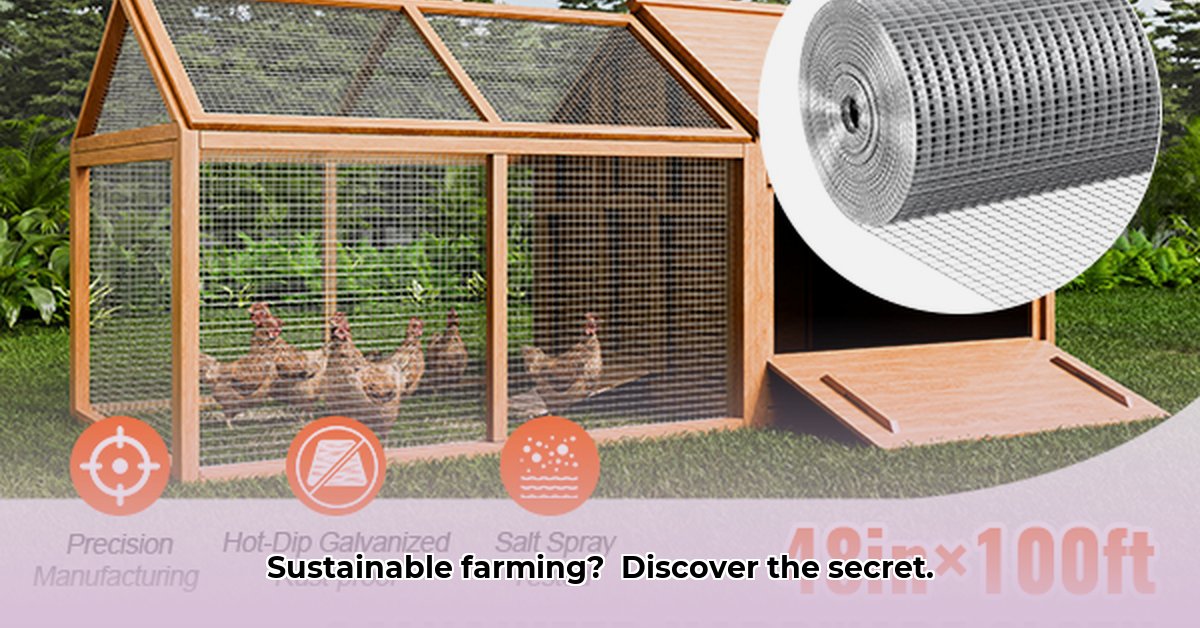
Choosing the right hardware cloth can significantly impact the success and sustainability of your farming operation. This guide provides actionable steps to select, install, and maintain hardware cloth from Tractor Supply, enhancing your pest control, soil conservation, and overall farm productivity. We'll explore the benefits and drawbacks of different types of hardware cloth, helping you make informed decisions for long-term success. For more on sustainable farming practices, check out this chicken tractor guide.
Selecting the Right Hardware Cloth for Your Needs
The first step is identifying your specific needs. What are you trying to protect? Rodents, birds, insects, or larger animals? The size of the mesh openings directly correlates to the size of the pests it can exclude. Fine mesh (smaller openings) is ideal for insects and small rodents, while larger mesh is suitable for larger animals. Consider also the material: galvanized steel is less expensive but prone to rust; aluminum is more expensive but provides superior corrosion resistance and longevity. Think long-term: Will the higher initial cost of aluminum pay off in reduced replacements and maintenance?
Understanding Material Choices: Galvanized Steel vs. Aluminum
Galvanized Steel: Offers lower initial cost, making it attractive for budget-conscious farmers. However, it's susceptible to rust and corrosion, particularly in damp climates, shortening its lifespan. Regular inspection and timely replacement are crucial.
Aluminum: Commands a higher upfront price, but its exceptional corrosion resistance translates to a significantly longer lifespan, minimizing replacement costs over time. This makes it a cost-effective choice in the long run, especially in harsh weather conditions.
Dr. Emily Carter, Agricultural Engineer at the University of California, Davis, states: "For sustainable agriculture, prioritizing longevity reduces waste and environmental impact. While galvanized steel might seem cheaper upfront, aluminum's superior corrosion resistance frequently leads to lower lifecycle costs."
A Step-by-Step Guide to Hardware Cloth Installation
Proper installation is key to maximizing the effectiveness of your hardware cloth. Follow these steps for optimal results:
Precise Measurements: Begin by accurately measuring the area needing protection. Inaccurate measurements lead to wasted material and compromised protection. Use a sturdy tape measure and take your time.
Cutting the Hardware Cloth: Employ heavy-duty wire cutters or shears for clean cuts. Always wear protective gloves to prevent injury from sharp edges.
Secure Attachment: Secure the hardware cloth using appropriate fasteners. Staples work well for wood, while wire ties provide flexibility for various structures. Landscape pins are useful for ground installations. Ensure the mesh is taut to prevent sagging and potential openings.
Overlapping for Enhanced Protection: Overlap edges to eliminate gaps and prevent determined pests from exploiting weaknesses. Secure the overlaps using your chosen fasteners.
Regular Inspections: Regularly inspect your hardware cloth for damage, tears, or holes. Promptly addressing minor issues prevents larger, more costly repairs down the line.
Evaluating the Pros and Cons of Hardware Cloth
Hardware cloth isn't a one-size-fits-all solution. While highly effective, it has limitations:
| Feature | Pros | Cons |
|---|---|---|
| Pest Control | Effective against a wide array of pests, from insects to larger animals. | Requires proper installation to avoid gaps and maintain effectiveness. |
| Durability | Available in various gauges (thicknesses) to suit different needs and budgets. | Susceptible to damage if not properly installed or maintained. (Galvanized steel rusts) |
| Cost-Effectiveness | Initially less expensive than some alternatives; aluminum offers long-term cost savings. | Initial cost can be substantial for large-scale projects. |
| Environmental Impact | Reusable and recyclable; some options utilize recycled materials. | The manufacturing process has an environmental impact, though usually less than alternatives. |
Expanding Hardware Cloth Applications in Sustainable Farming
Beyond pest control, hardware cloth boasts versatile applications:
Seedling Protection: Create individual shelters for vulnerable seedlings, improving survival rates.
Erosion Control: Stabilize soil on slopes, minimizing topsoil loss and promoting land conservation.
Frost Protection: Use as a row cover to protect plants from frost damage, helping to extend the growing season.
Trellis Support: Construct sturdy, reusable trellises for climbing plants, increasing yield and optimizing space.
Making Informed Decisions for a Sustainable Future
When purchasing hardware cloth, factor in longevity and materials. Choose recycled options whenever possible to minimize environmental impact. Consider disposal methods once the hardware cloth reaches the end of its life. Consult Tractor Supply's knowledgeable staff for expert advice tailored to your specific needs and location. Remember, investing in quality hardware cloth contributes to the long-term sustainability and profitability of your farm. Choosing the right material, proper installation and consistent maintenance means a healthier harvest and a more environmentally friendly operation.